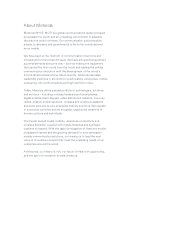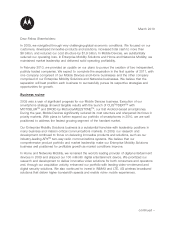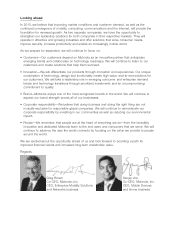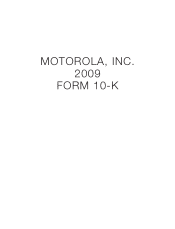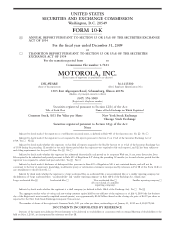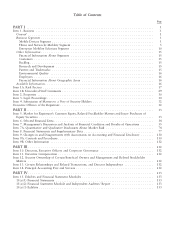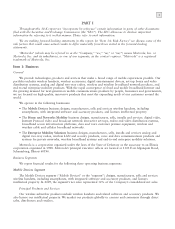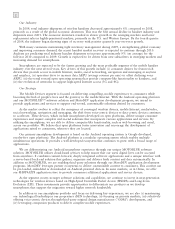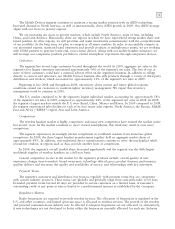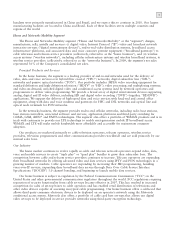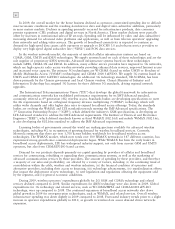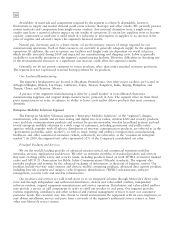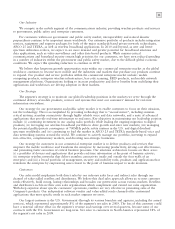Motorola 2009 Annual Report Download - page 12
Download and view the complete annual report
Please find page 12 of the 2009 Motorola annual report below. You can navigate through the pages in the report by either clicking on the pages listed below, or by using the keyword search tool below to find specific information within the annual report.
4
growth may also be affected by the cost of the new licenses required to use frequencies and any related frequency
relocation costs.
The U.S. leads the world in spectrum deregulation, allowing new wireless communications technologies to be
developed and offered for sale. Examples include wireless local area network systems, such as WiFi, and wide
area network systems, such as WiMAX and LTE. Other countries have also deregulated portions of their
available spectrum to allow deployment of these and other new technologies. Deregulation may introduce new
competition and new opportunities for Motorola and our customers.
Backlog
The segment’s backlog (excluding any deferred revenue) was $409 million at December 31, 2009, compared
to $290 million at December 31, 2008. This increase in backlog is primarily due to demand for our smartphones
that were launched in the fourth quarter of 2009. The 2009 backlog is believed to be generally firm and 100% of
that amount is expected to be recognized as revenue in 2010. The forward-looking estimate of the firmness of
such orders is subject to future events that may cause the amount recognized to change.
Intellectual Property Matters
Patent protection is extremely important to the segment’s operations. The segment has an extensive portfolio
of patents relating to its products, technologies and manufacturing processes. The segment licenses certain of its
patents to third parties and generates revenue from these licenses. Motorola is also licensed to use certain patents
owned by others. Royalty and licensing fees vary from year to year and are subject to the terms of the agreements
and sales volumes of the products subject to licenses. The protection of these licenses is also important to the
segment’s operations. For additional information relating to patents and trademarks and research and
development activities with respect to this segment, see the discussion under ‘‘Other Information.’’
Inventory, Raw Materials, Right of Return and Seasonality
The segment’s practice is to carry reasonable amounts of inventory in manufacturing and distribution centers
in order to meet customer delivery requirements in a manner consistent with industry standards. At the end of
2009, the segment had a significantly lower inventory balance than at the end of 2008. The decrease reflects
lower sales requirements and significant improvements in inventory management processes.
Availability of materials and components required by the segment is relatively dependable; however,
fluctuations in supply and market demand could cause selective shortages and affect results. We currently source
certain materials and components from single vendors. Any material disruption from a single-source vendor may
have a material adverse impact on our results of operations. If certain key suppliers were to become capacity
constrained or insolvent, it could result in a reduction or interruption in supplies or an increase in the price of
supplies and adversely impact the segment’s financial results.
Natural gas, electricity, and, to a lesser extent, oil are the primary sources of energy required for the
segment’s manufacturing operations. Each of these resources are currently in generally adequate supply for the
segment’s operations. In addition, the cost to operate our facilities and freight costs are dependent on world oil
prices, which steadily increased during 2009 and impacted our manufacturing and shipping costs. Labor is
generally available in reasonable proximity to the segment’s manufacturing facilities. However, difficulties in
obtaining any of the aforementioned resources or a significant cost increase could affect the segment’s results.
The segment permits returns under limited circumstances to remain competitive with current industry
practices.
The segment typically experiences higher sales in the fourth calendar quarter and lower sales in the first
calendar quarter of each year due to seasonal trends in the wireless handset industry.
Our Facilities/Manufacturing
The segment’s headquarters are located in Libertyville, Illinois. Our other major facilities are located in
Beijing and Tianjin, China; Jaguariuna, Brazil; Seoul, South Korea; and Plantation, Florida.
A significant portion of our handsets are manufactured either completely or substantially by a small number
of electronics manufacturing suppliers (‘‘EMSs’’) and ODMs. The segment relies on these third-party providers to
deliver products that meet consumer demands in the rapidly-changing technological environment. In 2009, our


